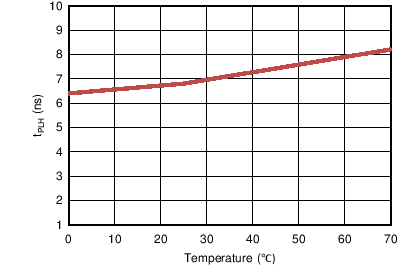SDLS021D May 1990 – April 2016 SN74LS07
PRODUCTION DATA.
- 1 Features
- 2 Applications
- 3 Description
- 4 Revision History
- 5 Pin Configuration and Functions
- 6 Specifications
- 7 Parameter Measurement Information
- 8 Detailed Description
- 9 Application and Implementation
- 10Power Supply Recommendations
- 11Layout
- 12Device and Documentation Support
- 13Mechanical, Packaging, and Orderable Information
封装选项
请参考 PDF 数据表获取器件具体的封装图。
机械数据 (封装 | 引脚)
- D|14
- DB|14
- N|14
- NS|14
散热焊盘机械数据 (封装 | 引脚)
订购信息
6 Specifications
6.1 Absolute Maximum Ratings
over operating free-air temperature range (unless otherwise noted)(1)| MIN | MAX | UNIT | |||
|---|---|---|---|---|---|
| VCC | Supply voltage | 7 | V | ||
| VI | Input voltage(2) | 7 | V | ||
| VO | Output voltage(2)(3) | 30 | V | ||
| TJ | Operating virtual junction temperature | 150 | °C | ||
| Tstg | Storage temperature | –65 | 150 | °C | |
(1) Stresses beyond those listed under Absolute Maximum Ratings may cause permanent damage to the device. These are stress ratings only, which do not imply functional operation of the device at these or any other conditions beyond those indicated under Recommended Operating Conditions. Exposure to absolute-maximum-rated conditions for extended periods may affect device reliability.
(2) All voltage values are with respect to GND.
(3) This is the maximum voltage that should be applied to any output when it is in the off state.
6.2 ESD Ratings
| VALUE | UNIT | |||
|---|---|---|---|---|
| V(ESD) | Electrostatic discharge | Human-body model (HBM), per ANSI/ESDA/JEDEC JS-001(1) | ±2000 | V |
| Charged-device model (CDM), per JEDEC specification JESD22-C101(2) | ±1000 | |||
(1) JEDEC document JEP155 states that 500-V HBM allows safe manufacturing with a standard ESD control process.
(2) JEDEC document JEP157 states that 250-V CDM allows safe manufacturing with a standard ESD control process.
6.3 Recommended Operating Conditions
over operating free-air temperature range (unless otherwise noted)(1)| MIN | NOM | MAX | UNIT | |||
|---|---|---|---|---|---|---|
| VCC | Supply voltage | 4.75 | 5 | 5.25 | V | |
| VIH | High-level input voltage | 2 | V | |||
| VIL | Low-level input voltage | 0.8 | V | |||
| VOH | High-level output voltage | 30 | V | |||
| IOL | Low-level output current | 40 | mA | |||
| TA | Operating free-air temperature | 0 | 70 | °C | ||
(1) All unused inputs of the device must be held at VCC or GND to ensure proper device operation. See the TI application report, Implications of Slow or Floating CMOS Inputs, SCBA004.
6.4 Thermal Information
| THERMAL METRIC(1) | SN74LS07 | UNIT | ||||
|---|---|---|---|---|---|---|
| D (SOIC) |
DB (SSOP) |
N (PDIP) |
NS (SO) |
|||
| 14 PINS | 14 PINS | 14 PINS | 14 PINS | |||
| RθJA | Junction-to-ambient thermal resistance | 85.2 | 97.4 | 50.2 | 82.8 | °C/W |
| RθJC(top) | Junction-to-case (top) thermal resistance | 43.5 | 49.8 | 37.5 | 40.9 | °C/W |
| RθJB | Junction-to-board thermal resistance | 39.7 | 44.5 | 30 | 41.4 | °C/W |
| ψJT | Junction-to-top characterization parameter | 10.9 | 16.5 | 22.3 | 12.4 | °C/W |
| ψJB | Junction-to-board characterization parameter | 39.4 | 44 | 29.9 | 41.1 | °C/W |
(1) For more information about traditional and new thermal metrics, see the Semiconductor and IC Package Thermal Metrics application report, SPRA953.
6.5 Electrical Characteristics
over recommended operating free-air temperature range (unless otherwise noted)| PARAMETER | TEST CONDITIONS(1) | MIN | TYP | MAX | UNIT | ||
|---|---|---|---|---|---|---|---|
| VIK | VCC = MIN, II = –12 mA | –1.5 | V | ||||
| IOH | VCC = MIN, VIH = 2 V | VOH = 30 V | 0.25 | mA | |||
| VOL | VCC = MIN, VIL = 0.8 V | IOL = 16 mA | 0.4 | V | |||
| IOL = MAX(2) | 0.7 | ||||||
| II | VCC = MAX, VI = 7 V | 1 | mA | ||||
| IIH | VCC = MAX, VI = 2.4 V | 20 | µA | ||||
| IIL | VCC = MAX, VI = 0.4 V | –0.2 | mA | ||||
| ICCH | VCC = MAX | 14 | mA | ||||
| ICCL | VCC = MAX | 45 | mA | ||||
(1) For conditions shown as MIN or MAX, use the appropriate value specified under recommended operating conditions.
(2) IOL = 40 mA
6.6 Switching Characteristics
VCC = 5 V, TA = 25°C (see Figure 2)| PARAMETER | FROM (INPUT) |
TO (OUTPUT) |
TEST CONDITIONS | MIN | TYP | MAX | UNIT | |
|---|---|---|---|---|---|---|---|---|
| tPLH | A | Y | RL = 110 Ω, CL = 15 pF | 6 | 10 | ns | ||
| tPHL | 19 | 30 | ||||||
6.7 Typical Characteristics
